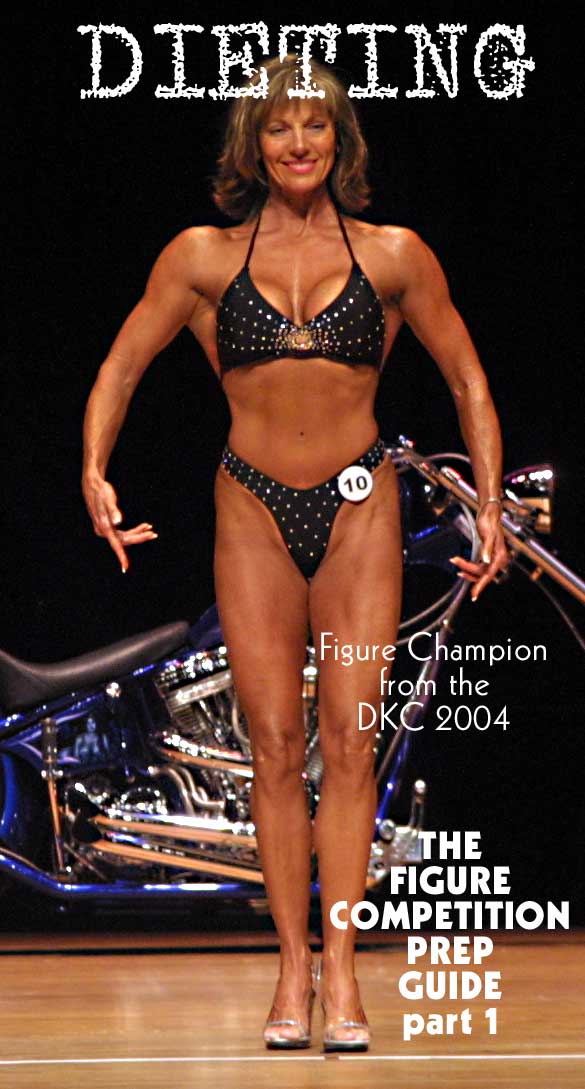|
The incredible Belinda
Cosmos in the photo above. A perfect 10. Winner of the Over 50 Figure
Class Winner at the 2004 Debbie Kruck Classic. Belinda was in amazing
shape in this contest and even more cut and beautiful in person.
GETTING LEAN:
Getting really lean is an art form. There is a lot more to it than
just starving yourself. In fact starving yourself would be the worst
thing you could do. If you need a basic primer in nutrition go here
and read this short course on ENERGY
and this short course on NUTRITION.
The information presented on this page assumes the reader has a
certain level of nutritional knowledge.
Have no clue about
eating and dieting and training?
Check out this web site. A very informative superb primer in
eating and training. Read all the stuff on that site-- the information
it provides goes directly along with what we are teaching here.
Let's get started: Remember
this information is intended for serious competitors and
is too severe and strict for a hobbyist or a person not already
in good shape (about 10 to 20 pounds out from top condition). It
requires months and months of devoted eating and training. Getting
in top shape does not happen by accident or overnight.
Basic
rules:
Eat every 3 hours. Six
small meals a day. Avoid foods that spike your insulin levels (like
bread, sugar, and pasta) or foods high in fat (bacon, cakes, butters,
dairy products, fatty meats). Focus on high fiber foods (vegetables,
whole wheat, fruits) and protein foods (whey protein, egg whites,
fish, lean chicken, lobster, and meal replacements).
HOW
MANY CALORIES EVERY DAY?
Calories: A general rule of thumb is 16 x your bodyweight. So if
your goal is to weigh 135 pounds that would be 2160 calories a day
intake to maintain a bodyweight of 135. To lose weight eat clean
and eat with a slight calorie deficit, about 200 to 300 calories
below your mainteneace level. Over time you will figure out the
correct balance.
You need to keep an eating
log and record your food intake so you can make accurate adjustments.
If you are very active you may have to eat more. If you are naturally
obese and hold onto bodyfat easily you may have to eat less. The
only way to really know (how a certain level of food intake will
affect you) is keep an eating log and discover what effect eating
a certain amount of calories for a month has on you. Ask yourself:
Did I get leaner? Did I lose muscle? Did I gain fat? Then make an
adjustment.
PROTEIN:
How much protein
should you eat every day? 1 gram of protein for every pound you
want to weigh or more. So lets say you are currently 140 pounds
but want to weigh a lean 125. (125 x 16 = 2000 calories a day).
Consume 125 grams of protein a day. That means 500 calories a day
in protein (125 x 4= 500). The rest of your calories come from carbs
and proteins. You can eat MORE protein if you want, as long as you
eat 2000 total calories a day.
CARBS:
CARBS: About 65% of total calories comes from carbs. Eat things
like vegetables, salads, whole wheat baking products, fruits, oat
meal, and rice. Avoid sugars, alcohol, snack cakes, chips, white
bread and white pastas, sodas, and candys. Eat carbs low on the
glycemic index.
FATS:
Fats: 10% or less of your total daily calories should come from
fats. When you do eat fat in should be the fat found in fish, nuts
and lean meats. Avoid fatty meats, dairy fats, butter, oil, and
snacks high in fat like french fries and cookies.
Plan on losing 1 pound
a week.
FAT LOSS PLAN TIPS
1. Eat every three
hours. This increases your metabolic rate. Eat 300 calories a
day below maintenance level. Do 30 minutes of aerobics a day.
Two, 30 minute sessions is good. Also eating every 3 hours tricks your body into thinking YOU ARE NOT DIETING (constant blood sugar level) so it does not store fat (go into famine mode).
2. Eliminate fat from
your diet. Protein's and carbs are not stored as easily as fat.
Fat is stored as fat. Eat fat, get, fat.
3. Decrease carbs without
cutting calories. Eat more vegetables and protein. Low carb lowers
insulin levels, you store very little fat, and activate fat burning
mechanisms in the body. Keep calories up.
4. When your metabolism
slows (from dieting), eat more for 1 to 3 days, sometimes a week. Usually one day will do it. Exercise
more as well. Get your metabolism going again. Usually 300 to
500 calories above maintenance will do it. If your bowel movements slow down from once a day to once every third day or something..it's a sure sign your BMR is slowing down.
5. Do cardio with no
carbs in the body. First thing in the morning is good. Always
a eat protein shake or a protein meal, before you do aerobics--so
you do not burn muscle. Do cardio after you weight train, not
before.
6. Switch from carbs
like potato's and rice and yams to more vegetables. You will get
more ripped.
7. No carbs in the
evening.
8.
Do not over-diet. A
tan bag of bones does not win a Figure Contest. It's not a contest
about who can starve themselves the most. Eat enough to maintain
your strength, energy and your muscles.
9. Keep your mind in the game. Read books like "RIPPED 2"; by Clarence Bass or listen to taps and TV shows that reinforce your dieting and training goals. I call this "brainwashing". I read "Ripped 2" (the first half) once a month to stay "brainwashed". This is a wonderful book and has helped me stay focused.
DIET 3 MONTHS OUT
|






